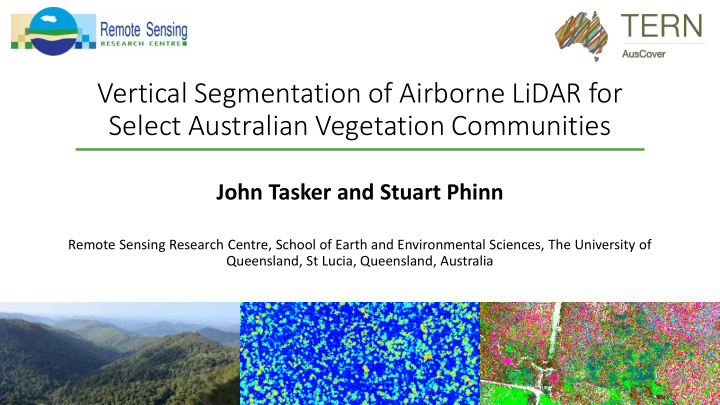



Vertical Segmentation of Airborne LiDAR for Select Australian Vegetation Communities John Tasker and Stuart Phinn Remote Sensing Research Centre, School of Earth and Environmental Sciences, The University of Queensland, St Lucia, Queensland, Australia
Overview 1. Background & Significance 2. Research Aim & Objectives 3. Study Sites 4. Methodology 5. Results – Vertical Segmentation 6. Results – Point Density Ratios 7. Results – Classification Comparisons 8. Summary
Background – Vertical Vegetation Structure • Key vegetation Tall Closed Forest classification criteria in 40m Australia 30m • Difficult to characterise sub-canopy structure 20m • Critical applications for 10m ecology & vegetation Low Open Shrubland management Photo: Applied Ecology
Background – LiDAR • Light Detection and Ranging (LiDAR) • Generates a 3D representation of an Return Waveform environment • Key Types: • Airborne Laser Scanner (ALS) • Terrestrial Laser Scanner (TLS) • Established technology for forestry & vegetation management Photo: IAN (graphics)
Significance & Research Aim • High spatial resolution LiDAR & field data increasingly available • Australian vegetation communities unique & challenging • Limited studies using ALS data in Australian context Research Aim To assess the ability of high spatial resolution LiDAR data to accurately map Australian vegetation communities.
Research Objectives 1. Gather and prepare datasets across a range of vegetation structural forms, from low shrubland to tall closed forest 2. Process LiDAR datasets to derive point density surfaces 3. Classify processed LiDAR datasets to map individual and stand based vegetation features 4. Assess differences between existing vegetation classifications and vertical point density derived classifications
Sensors & Data ALS • RIEGL Q560, flown at ~300m on N-S flight-lines • TERN AusCover data (2012-2013) Photo: TERN AusCover Site Name Point Density Spacing Area Covered 54.33 pts/m 2 26 km 2 Chowilla 0.14 m 28.87 pts/m 2 26 km 2 Litchfield 0.19 m 45.16 pts/m 2 13 km 2 Karawatha 0.15 m 50.68 pts/m 2 26 km 2 Robson Creek 0.14 m
Litchfield (NT) – Tropical Savanna Chowilla (SA) – Mallee Woodland/Scrub
Robson Creek (QLD) – Tropical Rainforest Karawatha (QLD) – Eucalypt Forest
Litchfield Robson Creek Chowilla Karawatha
Methodology Data Processing Classification Analysis Preparation • Vertical • ISODATA • Comparison: segmentation classification • Download • ISODATA vs using of segmented ALS data Specht LAStools data (TERN • ISODATA vs AusCover) • Point density • Specht TLS PAVD ratio classification • Preparation calculations using CHM & using using QGIS coverage LAStools data • CHM & coverage mapping
Methodology – Data Preparation Raw flight lines Pre-processed point cloud tile 30 m 20 m
Methodology - Processing Segmentation Pre-processed point Point cloud tile Density Rasters 30 m
Methodology – Classification & Accuracy Point Density Ratio Vegetation Community Point Density Calculation Classification Rasters Clustering Algorithm 600 m Standard Adaptive
Results – Vertical Segmentation • Data quality • Point densities • Vertical & horizontal accuracies • Spatial resolutions • 1 – 2 m 3 segments • Data size / software capacity • RAM limitations • LAStools functions Karawatha Segmentation Visualisation
Results – Point Density Ratios • Adaptive point density ratios • Improved identification of sub- canopy vegetation • Standard point density ratios • Effective for structurally simple vegetation • Segment point density requirements
Chowilla - Specht Chowilla - Exploratory
Litchfield - Specht Litchfield - Exploratory
Karawatha - Specht Karawatha - Exploratory
Robson Creek - Specht Robson Creek - Exploratory
Results – Classification Comparisons • Exploratory LiDAR-derived classifications • Classification of full vegetation structure (ground to canopy) • Characterisation of fine structural patterns (1-2 m segments) • Specht classifications • Primarily classified canopy vegetation • Overlap class for shrub/trees • Site-averaged PAVD data • Weak similarities (sample site vs whole site) • Additional analysis required
Summary • Vertical segmentation is an applicable method to characterise Australian vegetation communities • Fine spatial resolutions • Diverse range of vegetation communities • Point density ratio calculations • Standardise ALS point cloud datasets • Compensate for canopy return bias • Further work required to refine methods and processes
QUESTIONS John Tasker j.tasker@uq.edu.au
Recommend
More recommend